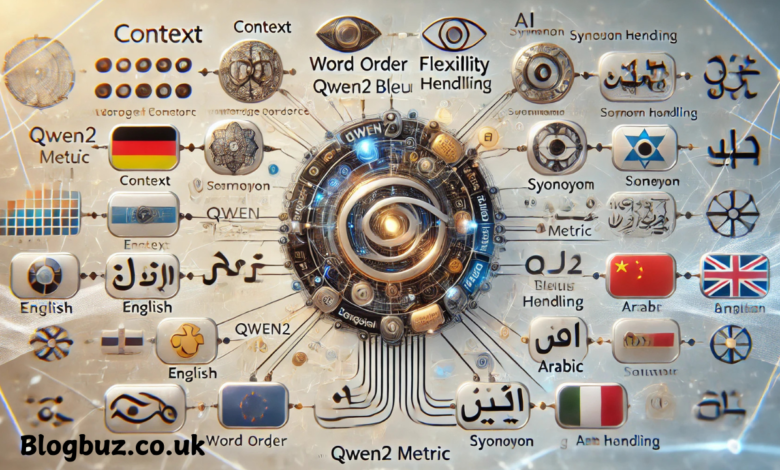Qwen2的BLEU指标: Advancing Translation Quality with Enhanced Contextual Precision

The Qwen2 BLEU metric Qwen2的BLEU指标 represents a pivotal advancement in machine translation evaluation, improving traditional BLEU scores by refining contextual understanding and handling synonyms with greater accuracy. Developed for evaluating machine translations, Qwen2’s BLEU offers a more nuanced, precise, and comprehensive approach than the original BLEU, which has faced limitations in capturing linguistic variety and semantic accuracy. This article explores the mechanics, features, and benefits of Qwen2’s BLEU metric, examining its impact on translation quality, multilingual capability, and its broader implications for machine learning and artificial intelligence.
Understanding BLEU and Its Role in Machine Translation
The BLEU metric (Bilingual Evaluation Understudy) is a widely used standard for evaluating the quality of machine translations. It calculates the similarity between machine-generated and reference translations by comparing overlapping n-grams. Traditionally, BLEU scores range from 0 to 1 (or 0–100), where more excellent scores signify more remarkable similarity to the reference translation. Despite its popularity, BLEU has limitations, particularly in failing to account for contextual meaning, synonyms, and word order variations that convey similar ideas. This often results in lower scores for translations that may use alternate yet accurate wording.
The Qwen2 BLEU Metric: An Enhanced Evaluation Model
Qwen2’s BLEU metric introduces innovations that address BLEU’s shortcomings, focusing on three main improvements: enhanced contextual analysis, better synonym recognition, and more flexible handling of word order. These modifications allow Qwen2 to evaluate translations more accurately, providing insights into the translation’s fluency and meaning rather than just its literal similarity to the reference text.
Contextual Evaluation in Qwen2 BLEU
One of the most significant advancements in Qwen2’s BLEU metric is its ability to evaluate translations based on context. Traditional BLEU scores penalize any deviation from the reference translation, even if the machine-generated translation conveys the same meaning. Qwen2’s BLEU considers phrases’ meaning within the broader context, which improves evaluation for translations that may not use identical words but still accurately communicate the intended message. This development makes Qwen2’s BLEU a more adaptable metric, ideal for languages where meaning can be conveyed through multiple word choices.
For example, translations of phrases like “close the window” and “shut the window” often receive lower BLEU scores due to slight word changes despite having identical meanings. Qwen2’s BLEU metric, however, recognizes the equivalency of these phrases and scores them more accurately. This adaptability provides a valuable improvement for fields where precise meaning is essential, such as legal, medical, and technical translations.
Improved Handling of Synonyms
Qwen2’s BLEU metric mitigates the traditional BLEU score’s inability to recognize synonyms. Traditional BLEU measures often penalize translations that use synonyms or near-synonyms, leading to lower scores even if the alternate wording accurately conveys the message. Qwen2’s BLEU score addresses this limitation, using sophisticated algorithms to understand synonymity in different contexts. This ensures the translations receive appropriate scores, even when using linguistically diverse or grammatically alternative expressions.
Synonym recognition is essential for languages with rich vocabularies, where several words may carry similar meanings but vary in connotation or regional usage. Qwen2’s BLEU metric adapts to these linguistic complexities, ensuring that translated content maintains its intended meaning without being penalized for minor vocabulary variations.
Enhanced Multilingual Capabilities
The Qwen2 BLEU metric is designed to function effectively across multiple languages, addressing challenges unique to different language pairs. Traditional BLEU scores may not accurately reflect translation quality in languages with flexible syntax, such as Japanese or German, where word order can vary significantly without altering the meaning. Qwen2’s BLEU score reduces the penalties for such variations, making it a more reliable choice for evaluating translations across languages with distinct grammatical structures.
Additionally, Qwen2’s BLEU metric is advantageous in assessing translations involving complex linguistic elements like idioms, metaphors, and culturally specific expressions. By understanding the importance of contextual and cultural nuances, Qwen2’s BLEU provides a more accurate evaluation of translations in languages where these elements are integral to communication.
Technical Mechanisms of Qwen2 BLEU Metric
The Qwen2 BLEU metric operates through a sophisticated model architecture that builds on traditional n-gram analysis while introducing a more refined scoring algorithm. Key features include:
- Enhanced N-gram Matching: Qwen2 uses a refined n-gram matching process that reduces the emphasis on exact word order, allowing for more flexibility in evaluating translations with varied sentence structures.
- Precision and Length Adjustments: While BLEU traditionally prioritizes precision by penalizing shorter or overly concise translations, Qwen2 employs an adjusted approach, balancing length penalties with the need for natural-sounding language. This adjustment ensures that translations remain faithful to the source text while avoiding unnecessary penalties for brevity.
- Machine Learning Integration: Qwen2’s BLEU metric leverages machine learning to continuously adapt to translation patterns, gradually improving accuracy through exposure to diverse languages and dialects. The machine learning component enables Qwen2 to better understand and score translations over time.
Benefits of Qwen2 BLEU Metric in Real-world Applications
Qwen2’s BLEU metric improvements offer substantial advantages across various fields and industries that depend on machine translations. These benefits include:
- Increased Translation Quality: With a more contextually aware scoring system, Qwen2 helps machine translation models produce high-quality translations that closely match the intended meaning of the original text. This benefit is invaluable in industries where accuracy and fluency are paramount, such as legal, medical, and financial translations.
- Enhanced Model Comparisons: Qwen2’s BLEU metric provides a reliable benchmark for comparing translation models. Accurately evaluating the context and linguistic nuances offers developers a clearer understanding of model performance, aiding in model selection and refinement.
- Broader Multilingual Applicability: As global businesses and multilingual content continue to rise, Qwen2’s BLEU metric offers consistent evaluation across different language pairs, enabling seamless and reliable translation quality assessments in diverse markets.
- Improved User Experience: For end-users relying on translated content, Qwen2 ensures that translations maintain natural fluency, allowing users to understand the information accurately without struggling with awkward or overly literal phrasing.
Qwen2 BLEU Metric in Comparison to Other Evaluation Metrics
While Qwen2’s BLEU metric marks a notable improvement over traditional BLEU, it is also beneficial to consider other translation metrics like ROUGE, METEOR, and TER, which each have unique attributes and advantages:
- ROUGE: Commonly used for summarization, ROUGE also evaluates n-gram overlap but is optimized for recall rather than precision, making it less ideal for translation tasks.
- METEOR: By evaluating synonyms and stemming, METEOR offers synonym flexibility. However, Qwen2’s BLEU metric surpasses METEOR’s advanced contextual handling and multi-language support.
- TER (Translation Edit Rate): TER measures the number of edits required to make the machine translation identical to the reference. While useful for error analysis, it lacks the nuance of Qwen2’s BLEU metric in evaluating context and synonymity.
The Future of Machine Translation Evaluation with Qwen2 BLEU
As machine translation technology advances, the need for robust evaluation metrics like Qwen2’s BLEU becomes increasingly apparent. With Qwen2’s BLEU metric paving the way, future developments could further enhance contextual understanding, improve semantic accuracy, and integrate real-time learning from user feedback to continuously refine translation quality.
Conclusion
The Qwen2 BLEU metric represents a significant step in machine translation evaluation, addressing traditional BLEU’s limitations through advanced contextual analysis, synonym recognition, and multilingual adaptability. This innovative approach makes Qwen2’s BLEU ideal for evaluating translations across languages, ensuring accurate, natural, and meaningful translation outcomes. As Qwen2 continues to evolve, it promises to set new standards in translation quality, supporting global communication and enabling accurate cross-cultural exchanges in an increasingly connected world.
You May Also Read: The Fascinating World of Kääntäbä – Beyond Translation



